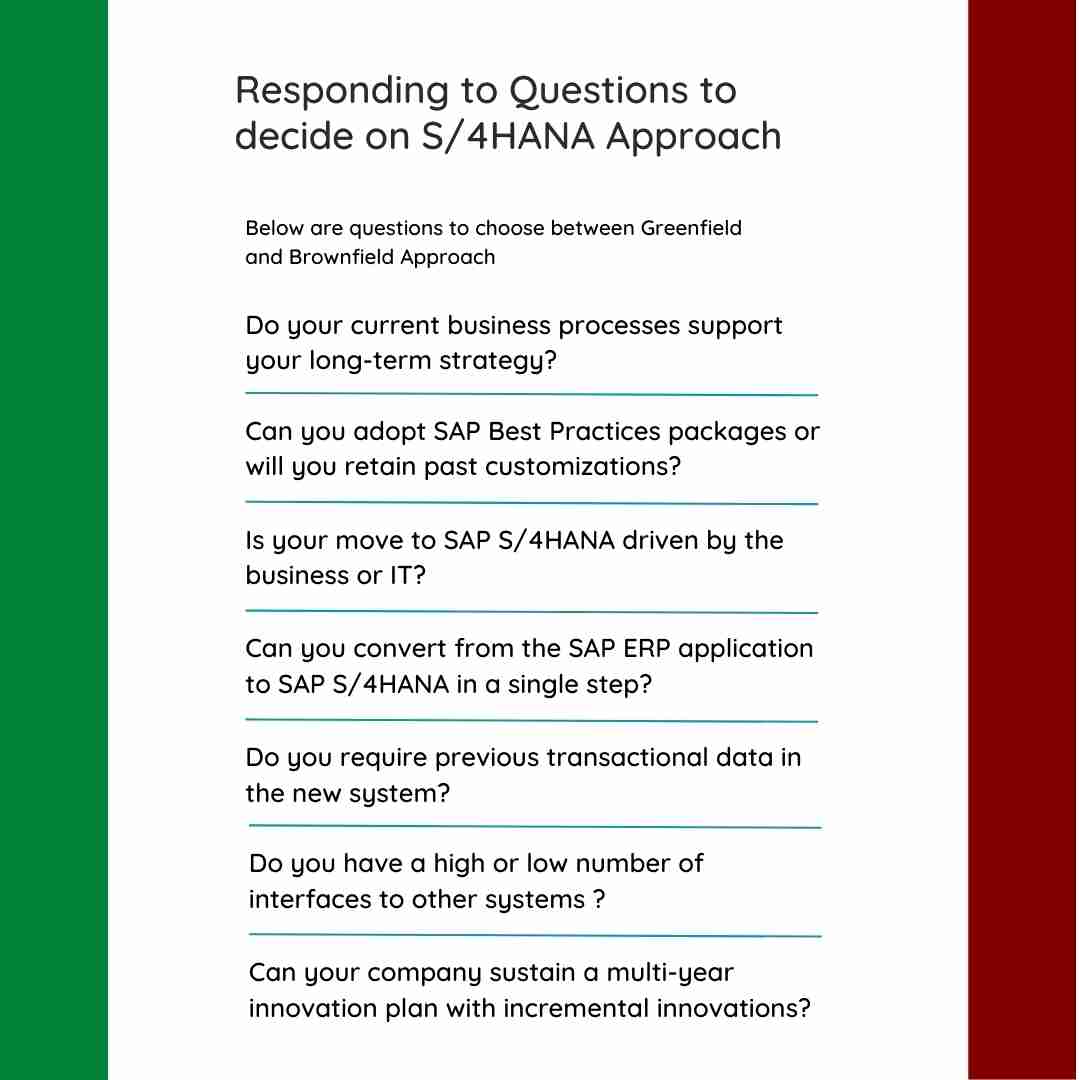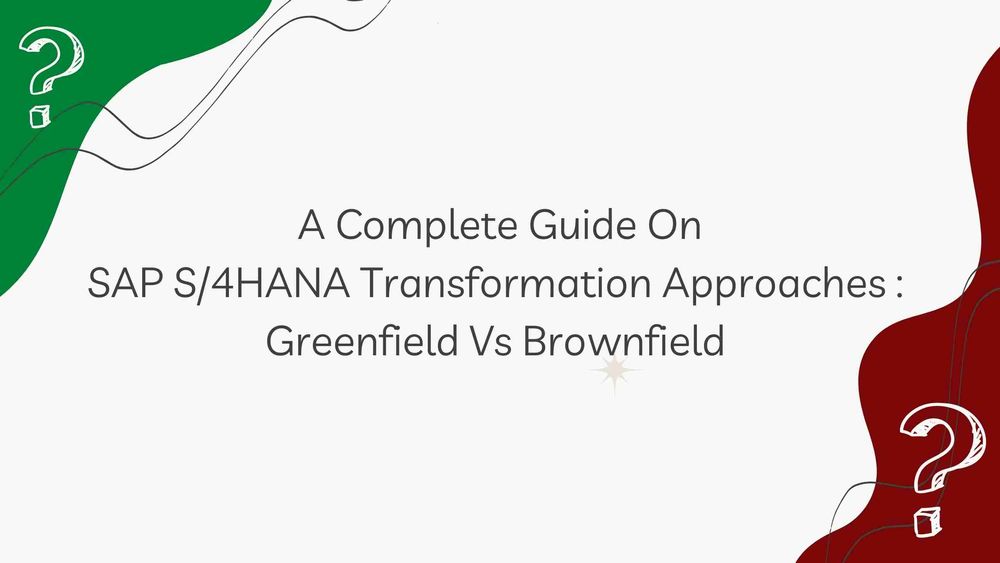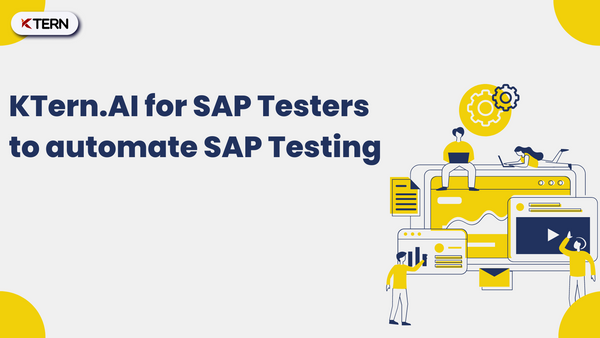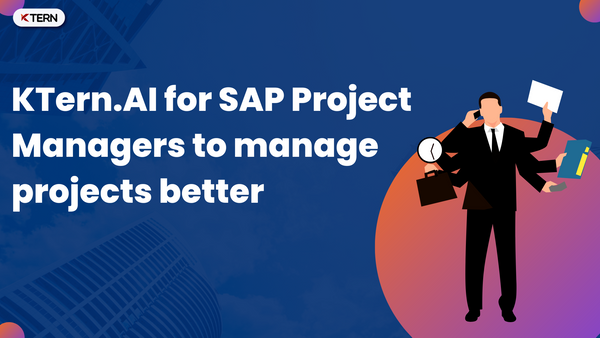A Complete Guide On SAP S/4HANA Transformation Approaches : Greenfield Vs Brownfield
History of SAP S/4HANA
To help customers run simpler, SAP has broken the limitations of its past via its innovation-based digital core product-SAP S/4HANA. On 3rd February 2015, SAP announced its new business suite fully built on SAP HANA called SAP S/4HANA meaning SAP Business Suite 4 SAP HANA. This is considered to be the latest product and most significant innovation of SAP since the R/3 System.

SAP HANA
SAP HANA is an in-memory, column-oriented, relational database management system developed and marketed by SAP SE. Its primary function as a database server is to store and retrieve data as requested by the applications. In addition, it performs advanced analytics (predictive analytics, spatial data processing, text analytics, text search, streaming analytics, graph data processing) and includes ETL capabilities as well as an application server.
SAP S/4HANA
SAP S/4HANA is the next-generation business suite. It is a new product fully built on the most advanced in-memory platform today — SAP HANA — and modern design principles with the SAP Fiori user experience (UX). SAP S/4HANA delivers massive simplifications (customer adoption, data model, user experience, decision making, business processes, and models) and innovations (Internet of Things, Big Data, business networks, and mobile-first) to help businesses run simpler in the digital economy.

Migrating a system from SAP ERP ECC to SAP S/4HANA is considered as a highly risky process as the whole system gets converted to another form for all SAP S/4HANA Implementation Partners. In order to know how KTern helps in migrating from SAP ECC to S/4HANA with simple and powerful proven techniques.
S/4HANA Migration Approaches
There are numerous ways you could think of in terms of migrating an SAP S/4HANA system. There are some key factors that could influence your approach to SAP S/4HANA Transformation, they include :
- SAP System Architecture
- SAP Data Quality
- Deployment Approach
- Long-Term Strategy
- Future Business and IT Needs
- Level of Customizations in the existing System
- Size of SAP ECC Database
- Reporting Needs
- Business Process Maturity
In this writeup, the major objective is to have detailed information on each approach with :
- Basis to Approach
- Pros and Cons
- Comparison of each approach
- Next Steps
Before New Implementation (Greenfield) vs System Conversion (Brownfield)
SAP has long been an undisputed market leader in the ERP space. Today, SAP S/4HANA is helping companies around the world to become intelligent enterprises. As hundreds of new SAP S/4HANA systems go live every month, more and more customers are looking for guidance on how to start their journey to the new digital core.
The way you plan and execute the SAP S/4HANA program will substantially influence your ability to adopt next-generation business processes and use the new capabilities of SAP products. Needless to say, making the right choices here is of paramount importance.
Differences
With a new greenfield implementation, you build a new SAP S/4HANA system and either cut over to the new system (the so-called “big bang” scenario) or migrate the individual business units sequentially from your legacy SAP ERP application to the new system (“a phased rollout”).
With a system conversion or brownfield implementation, you turn your existing SAP ERP system into an SAP S/4HANA system. Technically, the system conversion is a one-step procedure with a single downtime and comprises of the following:
- For SAP ERP on any database: a database migration to SAP HANA 2.0 (a new database system)
- A conversion of the data from the SAP ERP data model to the SAP S/4HANA data model
- A software upgrade, that is, replacing SAP ERP application code with SAP S/4HANA application code
For SAP ERP powered by SAP HANA, the transition to SAP S/4HANA is an in-place upgrade. It also requires an upgrade from SAP HANA 1.0 to SAP HANA 2.0 as an extra step. The records over the past three years show that the vast majority of SAP ERP customers decide either on conversion or on new implementation – in almost equal parts. About 5% choose other options because of their specific situations and requirements.
In the end, there is no right or wrong way. Each customer needs to choose the option that best allows them to continuously adopt SAP innovations in the future.
Key Considerations influencing the choice between a Greenfield and Brownfield Implementation
- Do your current business processes support your long-term strategy?
- Can you adopt SAP Best Practices packages or will you retain past customizations?
- Is your move to SAP S/4HANA driven by the business or IT?
- Can you convert from the SAP ERP application to SAP S/4HANA in a single step?
- Do you require previous transactional data in the new system?
- Are landscape consolidation and process harmonization key value drivers?
- Do you have a high or low number of interfaces to other systems (SAP and third-party)?
- Can your company sustain a multi-year innovation plan with incremental innovations?
We’ll go through each of the above points and explain the impact it will have on choosing the right path for your SAP S/4HANA migration.

1. Do your current Business Processes support your Long-Term strategy?
If your long-term strategy implies the need for business process redesign in the business areas considered key to strategic growth, or the ones expected to deliver substantial cost savings, then this is a strong indication for a greenfield implementation. If your SAP ERP system today takes no advantage of best practices or relies on dated functionality (for instance, business areas instead of profit center accounting), a new implementation is a better choice. Likewise, if you run an oversized, overcomplicated, historically grown system, a greenfield implementation is a more attractive option.
2. Can you adopt SAP Best Practices packages or will you retain past customizations?
Do you plan to make extensive use of SAP Best Practices packages and SAP Model Company services? If so, a greenfield implementation is a better choice. By contrast, if you see your custom enhancements and modifications as a major asset supporting your company’s unique way of operating and intend to preserve them, a brownfield conversion is a more attractive option for you.
3. Is your move to SAP S/4HANA driven by the business or by IT?
It’s virtually impossible to start a business transformation out of an IT project. IT-sponsored projects are typically system conversions that lay the foundation for later innovation projects driven by the business.
4. Can you convert from the SAP ERP application to SAP S/4HANA in a single step?
Technically, single-step conversion is possible for SAP ERP 6.0 (any enhancement package) single-stack, Unicode systems. Systems that don’t fulfill these criteria have likely experienced little maintenance in the past years. In practice, systems with dated software release levels may require somewhat more effort than the ones recently updated.
If the system can’t be converted technically in a single step, a greenfield implementation is a better choice, because the combined cost of an upgrade to SAP ERP 6.0 or a Unicode upgrade followed by a conversion to SAP S/4HANA would be prohibitively high. Moreover, combining two upgrades in a single downtime will most probably exceed the maximum system outage your business can afford.
The second factor to consider here is your rollout strategy. If you plan to roll out the system on a company-code-by-company-code basis, then a greenfield implementation approach is a better option. However, if this rollout strategy is a precaution rather than a hard constraint, you should take into account the implied cost of integrating the old and new system landscape, such as for intercompany scenarios, master data synchronization, and consolidation. Often, putting more attention on testing is a far more effective risk mitigation strategy.
5. Do you require previous transactional data in the new system?
When choosing between a greenfield and brownfield implementation, the requirement to retain all data in the system is a very strong indication for a system conversion. The first response is often, “Yes, we do need all data in the new system.” However, you should challenge this standpoint and design a data strategy that takes into account the available technological alternatives.
6. Are landscape consolidation and process harmonization key value drivers?
For companies with a track record of mergers and acquisitions, it’s often easier for different divisions to agree on a new neutral set of best practices than to debate which of the current ERPs should become the consolidation target. In this case, opt for a greenfield implementation and consolidate the system configurations and data required to start business operations into this new SAP S/4HANA system.
7. Do you have a high or low number of interfaces to other systems (SAP and third-party)?
In greenfield implementations, interfaces have to be (re)developed and tested, especially interfaces to third-party solutions. With a brownfield conversion, adjusting existing interfaces typically takes less effort. Thus, a high number of interfaces in the current system makes a stronger case for brownfield implementation. However, before settling on this decision, consider the new integration technologies SAP offers, especially the SAP Cloud Platform Integration and SAP Cloud Platform Integration Advisory services.
8. Can your company sustain a multi-year innovation plan with incremental innovations?
Although this aspect is entirely non-technical, it may in the end overturn all of the above considerations. If incremental innovation is part of your company’s philosophy, a brownfield conversion followed by innovative projects will lead to the desired outcome. However, other companies may not deem themselves capable of persistently executing a multi-year plan because they expect a shift in focus or a major change in strategy. In such cases, a greenfield implementation is the only chance to harvest the full value of SAP S/4HANA.
SAP S/4HANA Greenfield Approach (also known as) New Implementation
Basis to Approach
If you plan to start your ERP Implementation from scratch by following the best practices and the latest innovations from SAP. This one is for you. A Greenfield Approach or New Implementation Approach to SAP S/4HANA from your existing legacy ECC System is a complete reengineering of your existing SAP Processes, Workflows, Data Definitions, and sometimes System Architecture.
You need to be aware of the fact that any customizations that you have built as part of your legacy system would be wiped out and you will have to start clean. If you rely heavily on your SAP customizations and WRICEF Objects, you are at a critical point.
Pros and Cons: Greenfield Approach
Though there is a relatively higher disruption, a Greenfield S/4HANA Implementation Methodology offers greater ROI in different ways :
- Promoting standardization to the business processes
- Removes dependency on customizations
- Easier adoption of SAP Best Practices
- Impacts Business Process KPIs directly by re-engineered processes
Moving away from legacy customizations (Spaghetti code)
For a legacy enterprise that's been using the SAP systems for far too long and is highly dependent on its customizations, the greenfield approach gives a fresh start with pre-built best practices hence reducing the system complexity to a greater extent.
Multiple Deployment options
Greenfield Approaches can be done either on-premise or in the cloud, thus enabling you to predefine your deployment strategy. If your long-term view is cloud-first, this option gives you the flexibility to choose that.
Time To Value
One of the key factors in ERP transformations is the duration of the project and the time to value. Although in theory, you can have your system up and running in less than 4 months. In reality, the duration can be relatively much longer with significant workshops and preparation in terms of data.
Business Disruption
The Greenfield Approach is more disruptive in nature and can cause adoption failures if the change management is not handled by the best practices. If you depend more on customizations, you will run into the risks of redoing them that might not completely replace the existing customization built over years or sometimes decades.
Redoing your customizations could be challenging without proper workshops and design.
In Short, You are simply buying a new phone with the latest innovations and features. While your notification preferences, contact data, and media information all need to be imported.

Brownfield Approach - System Conversion
Basis to Approach
While a Greenfield Approach is more like buying a new phone, a brownfield approach is more like a system upgrade. Using brownfield, you are simply upgrading your existing ECC system to your target SAP S/4HANA while retaining your customizations, data, and workflows.
Pros and Cons: Brownfield Approach
Pros and Cons :
You get to realize the move to S/4HANA gradually by simply moving your existing system to SAP S/4HANA by leveraging sophisticated tools that upgrade your system to the target S/4HANA version.
- Lift and Shift Approach that guarantees quick move to S/4HANA Environment
- Ability to retain proven business customizations and workflows
- Minimized delays and disruption to the existing business
- Gradual Innovation timeline
Time To Value
One of the greatest Advantages of the Brownfield Approach is there is usually a relatively shorter project runtime and therefore, less disruption to the business.
Business Innovation
You get to keep all of your business process configurations and customizations that you have been using in the ECC Environment. This can be a double-edged sword as you don't go through the pain of redoing your customization but you end up losing on innovating.
Simplifications and Custom Code
While the Brownfield approach might seem lean and faster, it comes with the risk of SAP Simplification items and Custom Code Remediation Processes. These could cause disruptions to the nature of business processes and your customizations.

Selective Data Transition Approach
You can combine the pros of both Greenfield and Brownfield Implementations using a hybrid strategy. Large Businesses with multiple satellite systems and a lot of data can opt for this strategy.

Which Approach is Better?
From multiple assessment studies using KTern.AI for S/4HANA Transformations, a full greenfield approach has been the least opted route.
The Approach you chose will be driven by the objectives listed above. The type of approach also defines if your transformation is Business Led S/4HANA Transformation or IT Led S/4HANA Transformation
If you want to make the best use of the innovation and go cloud-first, prefer the greenfield approach that helps you harmonize your business processes and adopt the latest cloud products like :
- SAP SuccessFactors
- SAP Ariba
- SAP Fieldglass
However, if you are single centralized ECC systems that want to keep your existing data and look at a quicker time to value, then Brownfield Approach, also known as System Conversion might be the logical route.
Plan your transformation by performing KTern.AI Assessment Study driven by your existing ERP Data.




